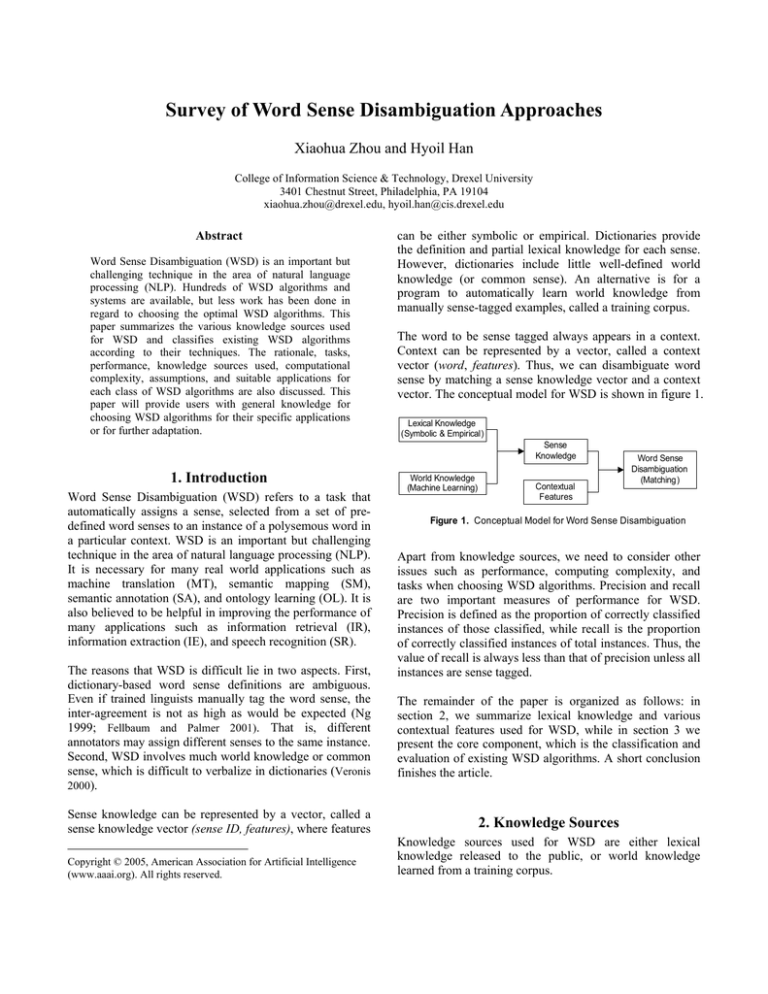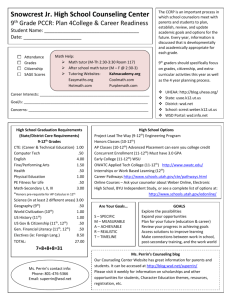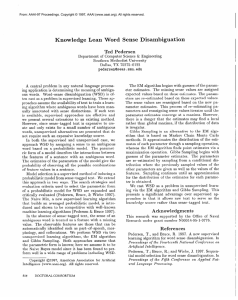
Survey of Word Sense Disambiguation Approaches
Xiaohua Zhou and Hyoil Han
College of Information Science & Technology, Drexel University
3401 Chestnut Street, Philadelphia, PA 19104
xiaohua.zhou@drexel.edu, hyoil.han@cis.drexel.edu
Abstract
Word Sense Disambiguation (WSD) is an important but
challenging technique in the area of natural language
processing (NLP). Hundreds of WSD algorithms and
systems are available, but less work has been done in
regard to choosing the optimal WSD algorithms. This
paper summarizes the various knowledge sources used
for WSD and classifies existing WSD algorithms
according to their techniques. The rationale, tasks,
performance, knowledge sources used, computational
complexity, assumptions, and suitable applications for
each class of WSD algorithms are also discussed. This
paper will provide users with general knowledge for
choosing WSD algorithms for their specific applications
or for further adaptation.
can be either symbolic or empirical. Dictionaries provide
the definition and partial lexical knowledge for each sense.
However, dictionaries include little well-defined world
knowledge (or common sense). An alternative is for a
program to automatically learn world knowledge from
manually sense-tagged examples, called a training corpus.
The word to be sense tagged always appears in a context.
Context can be represented by a vector, called a context
vector (word, features). Thus, we can disambiguate word
sense by matching a sense knowledge vector and a context
vector. The conceptual model for WSD is shown in figure 1.
Lexical Knowledge
(Symbolic & Empirical)
Sense
Knowledge
1. Introduction
Word Sense Disambiguation (WSD) refers to a task that
automatically assigns a sense, selected from a set of predefined word senses to an instance of a polysemous word in
a particular context. WSD is an important but challenging
technique in the area of natural language processing (NLP).
It is necessary for many real world applications such as
machine translation (MT), semantic mapping (SM),
semantic annotation (SA), and ontology learning (OL). It is
also believed to be helpful in improving the performance of
many applications such as information retrieval (IR),
information extraction (IE), and speech recognition (SR).
The reasons that WSD is difficult lie in two aspects. First,
dictionary-based word sense definitions are ambiguous.
Even if trained linguists manually tag the word sense, the
inter-agreement is not as high as would be expected (Ng
1999; Fellbaum and Palmer 2001). That is, different
annotators may assign different senses to the same instance.
Second, WSD involves much world knowledge or common
sense, which is difficult to verbalize in dictionaries (Veronis
2000).
Sense knowledge can be represented by a vector, called a
sense knowledge vector (sense ID, features), where features
Copyright © 2005, American Association for Artificial Intelligence
(www.aaai.org). All rights reserved.
World Knowledge
(Machine Learning)
Contextual
Features
Word Sense
Disambiguation
(Matching)
Figure 1. Conceptual Model for Word Sense Disambiguation
Apart from knowledge sources, we need to consider other
issues such as performance, computing complexity, and
tasks when choosing WSD algorithms. Precision and recall
are two important measures of performance for WSD.
Precision is defined as the proportion of correctly classified
instances of those classified, while recall is the proportion
of correctly classified instances of total instances. Thus, the
value of recall is always less than that of precision unless all
instances are sense tagged.
The remainder of the paper is organized as follows: in
section 2, we summarize lexical knowledge and various
contextual features used for WSD, while in section 3 we
present the core component, which is the classification and
evaluation of existing WSD algorithms. A short conclusion
finishes the article.
2. Knowledge Sources
Knowledge sources used for WSD are either lexical
knowledge released to the public, or world knowledge
learned from a training corpus.
2.1 Lexical Knowledge
In this section, the components of lexical knowledge are
discussed. Lexical knowledge is usually released with a
dictionary. It is the foundation of unsupervised WSD
approaches.
Sense Frequency is the usage frequency of each sense of a
word. Interestingly, the performance of the naïve WSD
algorithm, which simply assigns the most frequently used
sense to the target, is not very bad. Thus, it often serves as
the benchmark for the evaluation of other WSD algorithms.
Sense glosses provides a brief explanation of a word sense,
usually including definitions and examples. By counting
common words between the gloss and the context of the
target word, we can naively tag the word sense.
Concept Trees represent the related concepts of the target
in the form of semantic networks as is done by WordNet
(Fellbaum 1998). The commonly used relationships include
hypernym, hyponym, holonym, meronym, and synonym.
Many WSD algorithms can be derived on the basis of
concept similarity measured from the hierarchal concept
tree.
Selectional Restrictions are the semantic restrictions
placed on the word sense. LDOCE (Longman Dictionary of
Contemporary English) senses provide this kind of
information. For example, the first sense of run is usually
constrained with human subject and an abstract thing as an
object. Stevenson & Wilks (2001) illustrates how to use
selectional restriction to deduct the suitable word sense.
Subject Code refers to the category to which one sense of
the target word belongs. In LDOCE, primary pragmatic
codes indicate the general topic of a text in which a sense is
likely to be used. For example, LN means “Linguistic and
Grammar” and this code is assigned to some senses of
words such as “ellipsis”, “ablative”, “bilingual”, and
“intransitive” (Stevenson and Wilks 2001). It could do
WSD in conjunction with topical words. Further details
could be found in (Yarowsky 1992; Stevenson and Wilks
2001).
Part of Speech (POS) is associated with a subset of the
word senses in both WordNet and LDOCE. That is, given
the POS of the target, we may fully or partially
disambiguate its sense (Stevenson & Wilks, 2001).
2.2 Learned World Knowledge
World knowledge is too complex or trivial to be verbalized
completely. So it is a smart strategy to automatically
acquire world knowledge from the context of training
corpora on demand by machine learning techniques. The
frequently used types of contextual features for learning are
listed below.
Indicative Words surround the target and can serve as the
indicator of target senses. In general, the closer to the target
word, the more indicative to the sense. There are several
ways, like fixed-size window, to extract candidate words.
Syntactic Features here refer to sentence structure and
sentence constituents. There are roughly two classes of
syntactic features. One is the Boolean feature; for example,
whether there is a syntactic object. The other is whether a
specific word appears in the position of subject, direct
object, indirect object, prepositional complement, etc.
(Hasting 1998; Fellbaum 2001).
Domain-specific Knowledge, like selectional restrictions,
is about the semantic restrictions on the use of each sense of
the target word. However, domain-specific knowledge can
only be acquired from training corpora, and can only be
attached to WSD by empirical methods, rather than by
symbolic reasoning. Hasting (1998) illustrates the
application of this approach in the domain of terrorism.
Parallel Corpora are also called bilingual corpora, one
serving as primary language, and the other working as a
secondary language. Using some third-party software
packages, we can align the major words (verb and noun)
between two languages. Because the translation process
implies that aligned pair words share the same sense or
concept, we can use this information to sense the major
words in the primary language (Bhattacharya et al. 2004).
Usually, unsupervised approaches use lexical knowledge
only, while supervised approaches employ learned world
knowledge for WSD. Examining the literature, however, we
found the trend of combination of lexical knowledge and
learned world knowledge in recently developed WSD
models.
3. Algorithms
According to whether additional training corpora are used,
WSD algorithms can be roughly classified into supervised
and unsupervised categories.
3.1 Unsupervised Approach
The unsupervised approach does not require a training
corpus and needs less computing time and power. It is
suitable for online machine translation and information
retrieval. However, it theoretically has worse performance
than the supervised approach because it relies on less
knowledge.
Simple Approach (SA) refers to algorithms that reference
only one type of lexical knowledge. The types of lexical
knowledge used include sense frequency, sense glosses
(Lesk 1986), concept trees (Agiree and Rigau 1996; Agiree
1998; Galley and McKeown 2003), selectional restrictions,
and subject code. It is easy to implement the simple
approach, though both precision and recall are not good
enough. Usually it is used for prototype systems or
preliminary researches.
training examples. The charm of this approach lies in its
continuous optimization of the trained model until it
reaches convergence.
Seed
Training
Predicting
Combination of Simple Approaches (CSA) is an
ensemble of the heuristics created by simply summing up
the normalized weights of separate simple approaches (SA).
Because multiple knowledge sources offer more confidence
on a sense being used than a single source does, the
ensemble usually outperforms any single approach (Agirre
2000). However, this method doesn’t address the relative
importance of each lexical knowledge source in the
question. One alternative is to learn the weights of various
lexical knowledge sources from training corpora by
machine learning techniques such as Memory Based
Learning (See section 3.2).
Iterative approach (IA) only tags some words, with high
confidence in each step maintained by synthesizing the
information of sense-tagged words in the previous steps and
other lexical knowledge (Mihalcea and Moldovan, 2000). It
is based on a fine assumption that words in a discourse are
highly cohesive in terms of meaning expression, and
consequently achieves high precision and acceptable recall.
Mihalcea and Moldovan (2000) use this approach,
disambiguating 55% of the nouns and verbs with 92.2%
precision. This approach is a good choice for applications
that need to sense tag all major words in text.
Recursive Filtering (RF) shares the same assumption as
the iterative approach. That is, the correct sense of a target
word should have stronger semantic relations with other
words in the discourse than does the remaining sense of the
target word. Therefore, the idea of the recursive filtering
algorithm is to gradually purge the irrelevant senses and
leave only the relevant ones, within a finite number of
processing cycles (Kwong 2000). The major difference
from an iterative approach is that it does not disambiguate
the senses of all words until the final step.
This approach leaves open the measure of semantic relation
between two concepts. Thus, it offers the flexibility of the
semantic relation measure ranging from the very narrow to
the very broad subject to the availability of lexical
knowledge sources at the point of implementation. Kwong
(2001) reports a system with maximum performance,
68.79% precision and 68.80% recall.
Bootstrapping (BS) looks like supervised approaches, but
it needs only a few seeds instead of a large number of
N
Convergence
Sense
Tagged
Cases
Y
End
Figure 2. Flow of Recursive Optimization Algorithm
As shown in Figure 2, it recursively uses the trained model
to predict the sense of new cases and in return optimizes the
model by new predicted cases. The key to the success of
this method is the convergence of the supervised model.
Yarowsky (1995) applies decision lists as the supervised
model and achieves 96.5% precision for 12 words on
average. Any supervised model can be adapted to this
approach as long as it can reach convergence. RO truly
achieves very high precision, rivaling supervised methods
while costing much less, but it is limited to sense
disambiguation of a few major words in text.
3.2 Supervised Approach
A supervised approach uses sense-tagged corpora to train
the sense model, which makes it possible to link contextual
features (world knowledge) to word sense. Theoretically, it
should outperform unsupervised approaches because more
information is fed into the system. Because more and more
training corpora are available nowadays, most recently
developed WSD algorithms are supervised. However, it
does not mean unsupervised approach is already out of
mode.
Supervised models fall roughly into two classes, hidden
models and explicit models based on whether or not the
features are directly associated with the word sense in
training corpora. The explicit models can be further
categorized according to the assumption of interdependence
of features. Log linear models (Yarowsky 1992; Chodorow
et al. 2000) simply assume each feature is conditionally
independent of others. Maximum Entropy (Fellbaum 2001;
Berger 1996) and Memory-based Learning do not make any
assumptions regarding the independence of features.
Decomposable models (Bruce 1999; O’hara et al. 2000)
select the interdependence settings against the training
corpus.
Log Linear Model (LLM) simply assumes that each
feature is conditionally independent of others. For each
sense si, the probability is computed with Bayes’ rule,
where cj is j-th feature:
p( s i | c1 ,..., ck ) =
p( c1 ,..., ck | si ) p( si )
p( c1 ,...ck )
Because the denominator is the same for all senses of the
target word, we simply ignore it. According to the
independence assumption, the term can be expressed as:
k
p ( c1 ,...ck | si ) = ∏ p ( c j | si ) .
Thus the sense for the test case should be:
k
Si
∑ log p(c
relative importance of each feature. The overlap metric (δ),
shown above, is the basic measure of distance between two
values of a certain feature. It uses exact matching for
symbolic features. To smooth this metric, Modified Value
Difference Metric (MVDM) was defined by Stanfill and
Waltz (1986) and further refined by Cost and Salzberg
(1993). It determines the similarity of values of a feature by
observing the co-occurrence of values with target classes.
δ ( xi , yi ) =
j =1
S = ARGMAX log p( si ) +
features. Information Gain and Information Ratio (Quinlan,
1993) are two frequently used metrics that address the
j
| si )
j =1
By counting the frequency of each feature, we can estimate
the term log p ( c j | si ) from training data. But the seeming
neatness of the algorithm can not hide its two defects: (1)
the independence assumption is clearly not reasonable; (2)
it needs some techniques such as Good-Turing (Good, 1953)
to smooth the term of some features, p ( c j | si ) , due to
data parse problem (Chodorow et al. 2000).
Decomposable Probabilistic Models (DPM) fix the false
assumption of log linear models by selecting the settings of
interdependence of features based on the training data. In a
typical decomposable model, some features are independent
of each other while some are not, which can be represented
by a dependency graph (Bruce and Wiebe 1999). The
Grling-Sdm system in (O’Hara et al. 2000), based on a
decomposable model, performs at an average level in the
SENSEVAL competition. It could achieve better
performance if the size of training data is large enough to
compute the interdependence settings of features.
Memory-based Learning (MBL) classifies new cases by
extrapolating a class from the most similar cases that are
stored in the memory (Daelemans 1999). The basic
similarity metric (Daelemans 1999) can be expressed as:
n
∆( X , Y ) = ∑ wiδ ( xi , yi )
i =1
Where:
⎧ xi − yi
⎪ max − min if numeric, else
i
i
⎪
δ ( xi , y i ) = ⎨ 0
if x i = y i
⎪ 1
if x i ≠ y i
⎪
⎩
In the absence of information about feature relevance, the
feature weight (wi) can be simply set to 1. Otherwise, we
can add domain knowledge bias to weight or select different
n
∑ P(c
j
| xi ) − P (c j | yi )
j =1
Because Memory-based Learning (MBL) supports both
numeric features and symbolic features, it can integrate
various features into one model. Stevenson and Wilks (2001)
built a WSD system using an MBL model and the recall
(the precision is the same) for all major words in text
surprisingly reaches 90.37% to the fine sense level.
Maximum Entropy (ME) is a typical constrained
optimized problem. In the setting of WSD, it maximizes the
entropy of Pλ(y|x), the conditional probability of sense y
under facts x, given a collection of facts computed from
training data. Each fact is linked with a binary feature
expressed as an indicator function:
⎧1 if sense y is under condition x
f ( x, y ) = ⎨
⎩0 otherwise
We find:
Pλ ( y | x) =
1
⎛
⎞
exp⎜ ∑ λi f i ( x, y ) ⎟
Z λ ( x)
⎝ i
⎠
Where Zλ (x) is the normalizing constant determined by the
requirement that
∑
y
Pλ ( y | x) = 1 for all x.
Thus the word sense of the test case should be:
y = arg max
y
1
⎛
⎞
exp⎜ ∑ λi f i ( x, y ) ⎟
Z λ ( x)
⎝ i
⎠
From the training data, the parameter λ can be computed by
a numeric algorithm called Improve Iterative Scaling
(Berger, 1996). Berger also presents two numeric
algorithms to address the problem of feature selection as
there are a large number of candidate features (facts) in the
setting of WSD.
Dang and Palmer (2002) apply ME to WSD. Although their
model includes only contextual features without the use of
lexical knowledge, the result is still highly competitive. But
ME model always contains a large number of features
because ME supports only binary features. Thus it is highly
computing intensive.
Expectation Maximum (EM) generally solves the
maximization problem containing hidden (incomplete)
information by an iterative approach (Dempster et al. 1977).
In the setting of WSD, incomplete data means the
contextual features that are not directly associated with
word senses. For example, given the English text and its
Spanish translation, we use a sense model or a concept
model to link aligned word pairs to English word sense, as
shown in figure 3 (Bhattacharya et al. 2004).
Figure 3. Translation Model (Bhattacharya et al, 2004)
Suppose the same sense assumption is made as in the
example. English word sense is the hidden variable and the
complete data is (We, Ws, T), denoted by X. The WSD is
equivalent to choosing a sense that maximizes the
conditional probability P(X|Y,Θ).
X (We , Ws , T ) = arg max P( X | Y , Θ)
T
Where:
Θ = { p(T ), p (We | T ), p(Ws | T )}
EM then uses an iterative approach, which consists of two
steps, estimation and maximization, to estimate the
parameters Θ from training data. EM is a kind of climbing
algorithm. Whether it can reach global maximum depends
on the initial value of the parameters. Thus, we should be
careful to initialize the parameters. It is often a good choice
to use lexicon statistics for initialization.
EM can learn the conditional probability between hidden
sense and aligned word pairs from bilingual corpora so that
it does not require the corpus to be sense-tagged. Its
Group
SA
CSA
IA
Tasks
all-word
all-word
all-word
Knowledge Sources
single lexical source
multiple lexical sources
multiple lexical sources
performance is still highly competitive. The precision and
recall of the concept model in (Bhattacharya et al, 2004)
reach 67.2% and 65.1% respectively. Moreover, it is
allowed to develop a big model for all major words for
WSD.
So far, we have examined the characteristics of all classes
of WSD algorithms. Table 1 briefly summarizes the tasks,
needed knowledge sources, the level of computing
complexity, resulting performance, and other features for
each class of algorithms. According to the information
above, we can choose the appropriate algorithms for
specific applications. For example, online information
retrieval requires quick response and provides a little
contextual information, thus simple approach (SA) or
combination of simple approach (CSA) might be a good
choice.
In general, knowledge sources available to the application
dramatically reduce the range of choices; computing
complexity is an important consideration for time-sensitive
applications; and the task type of the application further
limits the applicable algorithms. After that, we may take the
performance and other special characteristics into account
of WSD algorithm choice.
Examining the literature of WSD, we also identify three
trends with respect to the future improvement of algorithms.
First, it is believed to be efficient and effective for
improvement of performance to incorporate both lexical
knowledge and world knowledge into one WSD model
(Agirre et al. 2000; O’Hara et al. 2000; Stevenson & Wilks,
2001; Veronis, 2000). Second, it is better to address the
relative importance of various features in the sense model
by using some elegant techniques such as Memory-based
Learning and Maximum Entropy. Last, there should be
enough training data to learn the world knowledge or
underlying assumptions about data distribution (O’Hara et
al. 2000).
Computing
Complexity
low
low
low
Performance
Other Characteristics
low
better than SA
high precision
average recall
RF
all-word
single lexical source
average
average
flexible semantic relation
BS
some-word
sense-tagged seeds
average
high precision
sense model converges
LLM
some-word
contextual sources
average
above average
independence assumption
DPM
some-word
contextual sources
very high
above average
need sufficient training data
MBL
all-word
lexical and contextual sources
high
high
ME
some-word
lexical and contextual sources
very high
above average
feature selection
EM
all-word
bilingual texts
very high
above average
Local maximization problem
Table 1. Brief summaries for each class of WSD algorithms. “all-word” means the approach is appropriate to disambiguate the sense of all
major words (verb, noun, adjective and adverb) in text; “some-word” represents the suitable approach for sense disambiguation of some
major words (usually verb or noun). The performance in the fifth column refers to precision and recall by default.
4. Conclusions
This paper summarized the various knowledge sources used
for WSD and classified existing WSD algorithms according
to their techniques. We further discussed the rationale, tasks,
performance, knowledge sources used, computational
complexity, assumptions, and suitable applications for each
class of algorithms. We also identified three trends with
respect to the future improvement of algorithms. They are
the use of more knowledge sources, addressing the relative
importance of features in the model by some elegant
techniques, and the increase of the size of training data.
References
Agirre, E. et al. 2000. Combining supervised and unsupervised
lexical knowledge methods for word sense disambiguation.
Computer and the Humanities 34: P103-108.
Berger, A. et al. 1996. A maximum entropy approach to natural
language processing. Computational Linguistics 22: No 1.
Bhattacharya, I., Getoor, L., and Bengio, Y. 2004. Unsupervised
sense disambiguation using bilingual probabilistic models.
Proceedings of the Annual Meeting of ACL 2004.
Bruce, R. & Wiebe, J. 1999. Decomposable modeling in natural
language processing. Computational Linguistics 25(2).
Chodorow, M., Leacock, C., and Miller G. 2000. A Topical/Local
Classifier for Word Sense Identification. Computers and the
Humanities 34:115-120.
Hastings, P. et al. 1998. Inferring the meaning of verbs from
context Proceedings of the Twentieth Annual Conference of the
Cognitive Science Society (CogSci-98), Wisconsin, USA.
Kwong, O.Y. 1998. Aligning WordNet with Additional Lexical
Resources. Proceedings of the COLING/ACL Workshop on Usage
of WordNet in Natural Language Processing Systems, Montreal,
Canada.
Kwong, O.Y. 2000. Word Sense Selection in Texts: An Integrated
Model, Doctoral Dissertation, University of Cambridge.
Kwong, O.Y. 2001. Word Sense Disambiguation with an
Integrated Lexical Resources. Proceedings of the NAACL
WordNet and Other Lexical Resources Workshop.
Lesk, M. 1986. Automatic Sense Disambiguation: How to Tell a
Pine Cone from and Ice Cream Cone. Proceedings of the
SIGDOC’86 Conference, ACM.
Mihalcea, R. & Moldovan, D. 2000. An Iterative Approach to
Word Sense Disambiguation. Proceedings of Flairs 2000, 219-223.
Orlando, USA.
Ng, H.T., Lim, C. and Foo, S. 1999. A Case Study on InterAnnotator Agreement for Word Sense Disambiguation, in
Proceedings of the ACL SIGLEX Workshop: Standardizing
Lexical Resources.
O'Hara, T, Wiebe, J., & Bruce, R. 2000. Selecting Decomposable
Models for Word Sense disambiguation: The Grling-Sdm System.
Computers and the Humanities 34: 159-164.
Quinlan, J.R. 1993. C4.5: Programming for Machine Learning.
Morgan Kaufmann, San Mateo, CA.
Cost, S. & Salzberg, S. 1993. A weighted nearest neighbor
algorithm for learning with symbolic features, Machine Learning,
Machine Learning 10: 57-78.
Stevenson, M. & Wilks, Y. 2001. The Interaction of Knowledge
Sources in Word Sense Disambiguation. Computational
Linguistics 27(3): 321 - 349.
Daelemans, W. et al. 1999. TiMBL: Tilburg Memory Based
Learner V2.0 Reference Guide, Technical Report, ILK 99-01.
Tilburg University.
Stanfill, C. & Waltz, D. 1986. Towards memory-based reasoning,
Communications of the ACM 29(12): 1213-1228.
Dang, H.T. & Palmer, M. 2002. Combining Contextual Features
for Word Sense Disambiguation. Proceedings of the SIGLEX
SENSEVAL Workshop on WSD, 88-94. Philadelphia, USA.
Dempster A. et al. 1977. Maximum Likelihood from Incomplete
Data via the EM Algorithm. J Royal Statist Soc Series B 39: 1-38.
Fellbaum, C.1998. WordNet: An electronic Lexical Database,
Cambridge: MIT Press.
Fellbaum, C. & Palmer, M. 2001. Manual and Automatic
Semantic Annotation with WordNet. Proceedings of NAACL 2001
Workshop.
Galley, M., & McKeown, K. 2003. Improving Word Sense
Disambiguation in Lexical Chaining, International Joint
Conferences on Artificial Intelligence.
Good, I.F. 1953. The population frequencies of species and the
estimation of population parameters. Biometrica 40: 154-160.
Veronis, J. 2000. Sense Tagging: Don't Look for the Meaning But
for the Use, Workshop on Computational Lexicography and
Multimedia Dictionaries, 1-9. Patras, Greece.
Yarowsky, D. 1992. Word Sense Disambiguation Using Statistical
Models of Roget's Categories Trained on Large Corpora.
Proceedings of COLING-92, 454-460. Nantes, France.
Yarowsky, D. 1994. Decision Lists for Lexical Ambiguity
Resolution: Application to Accent Restoration in Spanish and
French. Proceedings of the 32nd Annual Meeting of the
Association for Computational Linguistics, Las Cruces, NM.
Yarowsky, D. 1995. Unsupervised Word Sense Disambiguation
Rivaling Supervised Methods. Meeting of the Association for
Computational Linguistics, 189-196.









